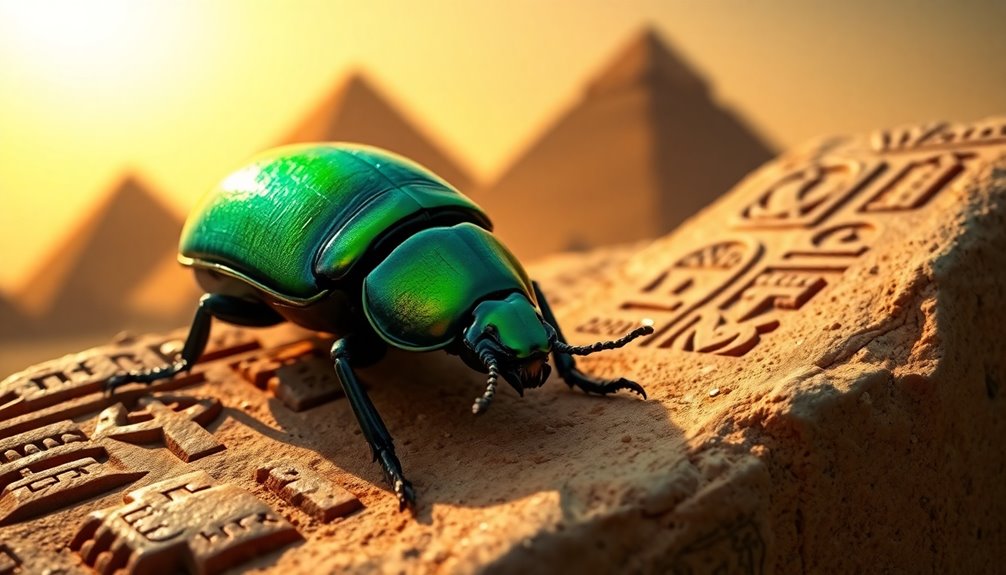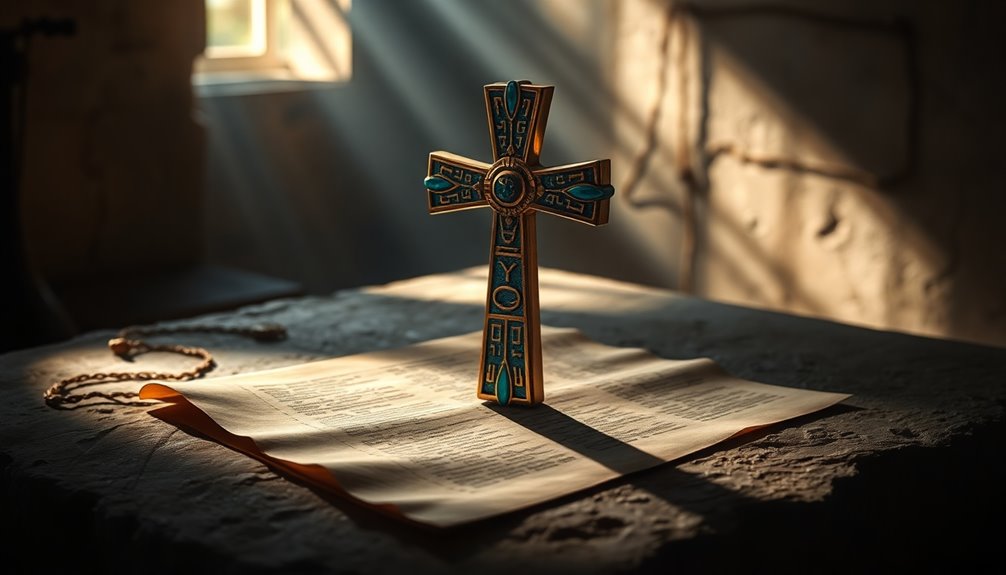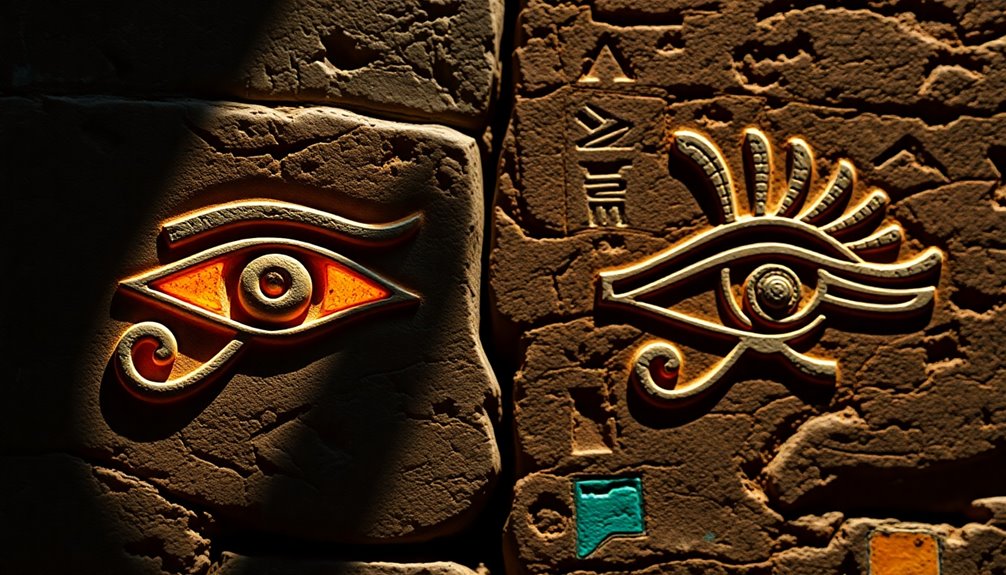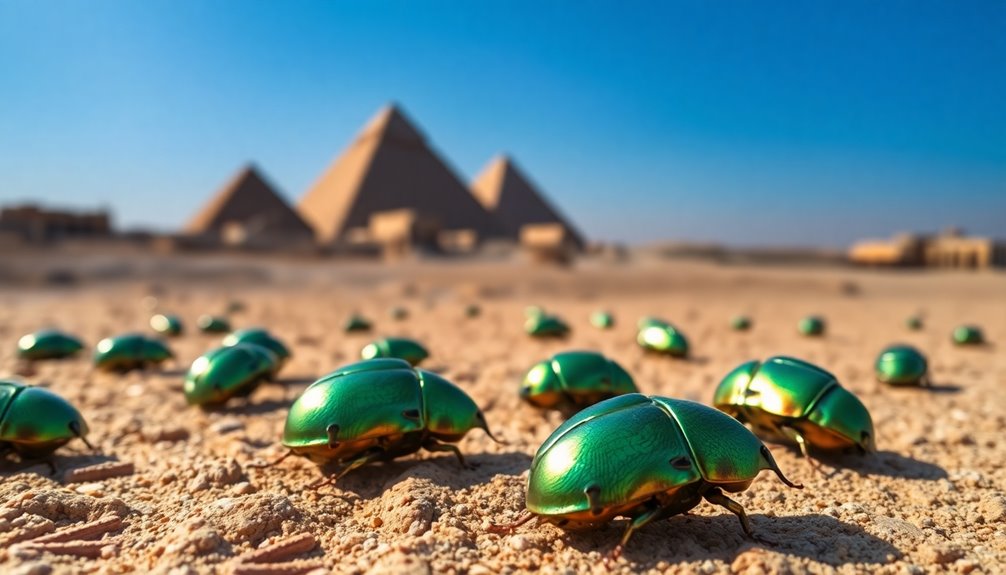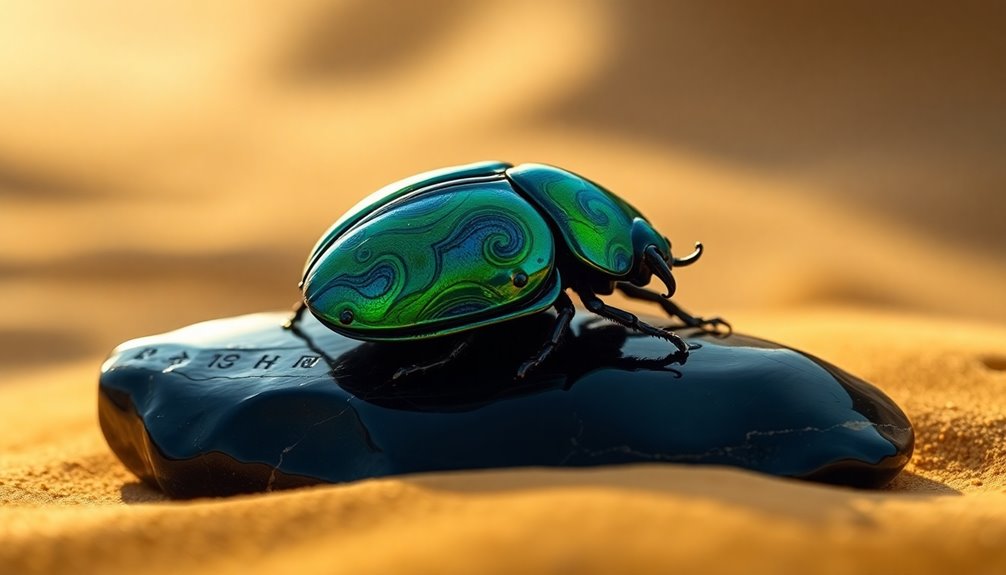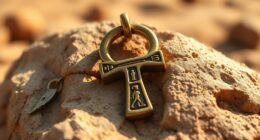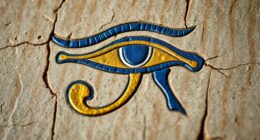The scarab beetle is more than just a creepy-cool insect; it's a powerful symbol in ancient Egyptian culture. Revered since 1500 BC, it represents life, rebirth, and protection. You'll find scarabs connected to Khepri, the god of the rising sun, embodying transformation and renewal. Historically, scarabs evolved from simple seals to intricate heart amulets used in funerary practices. They symbolized a divine connection and offered hope for eternal life. Today, these sacred insects inspire modern jewelry and tattoos, bridging ancient beliefs with contemporary expression. Keep exploring, and you'll uncover even more intriguing facets of the scarab's legacy.
Key Takeaways
- Scarab beetles, especially Scarabaeus sacer, were revered in ancient Egypt for symbolizing life, renewal, and the cycle of rebirth.
- They were associated with the sun god Khepri, representing transformation and the daily journey of renewal.
- Scarabs evolved from simple seals in the 6th Dynasty to elaborate heart scarabs used in funerary practices by the New Kingdom.
- Crafted from diverse materials like faience and gemstones, scarabs were integral to jewelry and tomb art, reflecting their cultural significance.
- Today, scarabs symbolize protection and good fortune, remaining popular in modern jewelry and tattoos, connecting ancient beliefs with contemporary culture.
Origins of the Scarab Beetle
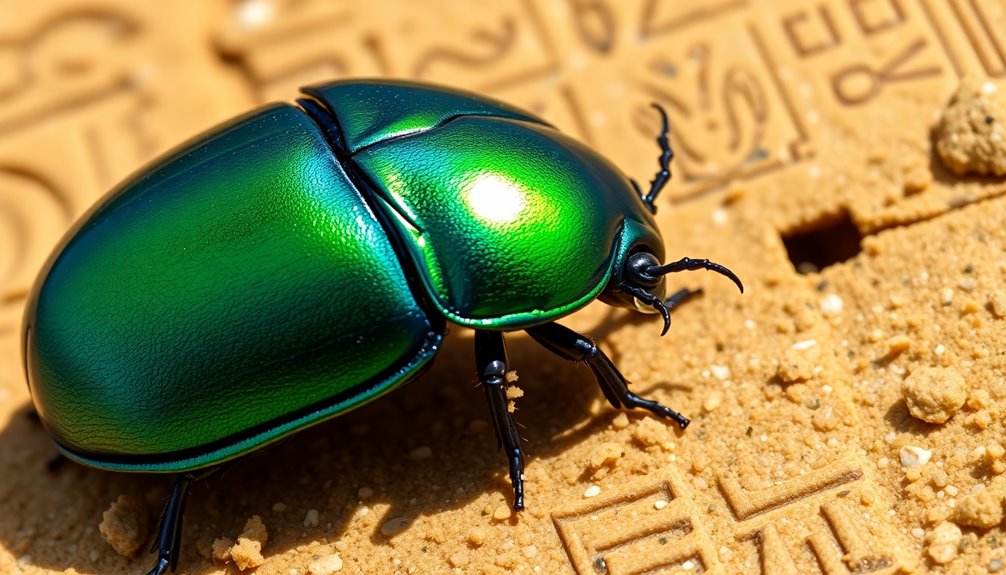
While many insects inhabit the Earth, the scarab beetle holds a unique place in history, particularly in ancient Egypt. Revered since around 1500 BC, this fascinating creature, known scientifically as Scarabaeus sacer, captivated the Egyptians with its remarkable behavior of rolling dung balls. To them, this act symbolized the cycle of life and renewal, making the scarab beetle a powerful emblem of transformation.
The scarab beetle was closely linked to Khepri, the god of the rising sun, who represented rebirth and immortality. Egyptians believed that just as the beetle rolled its dung ball, Khepri rolled the sun across the sky each day, signifying the eternal journey of the soul. This connection reinforced the beetle's significance in their cosmology.
Scarabs became protective symbols, often fashioned into amulets and depicted in carvings. These representations served not just as adornments but as essential links to the divine, instilling a sense of security in both life and the afterlife.
The prevalence of scarabs in ancient Egyptian art and hieroglyphics showcases their integral role in mythology, reflecting a deep reverence for the cycle of life they embodied.
Symbolism of Life and Rebirth
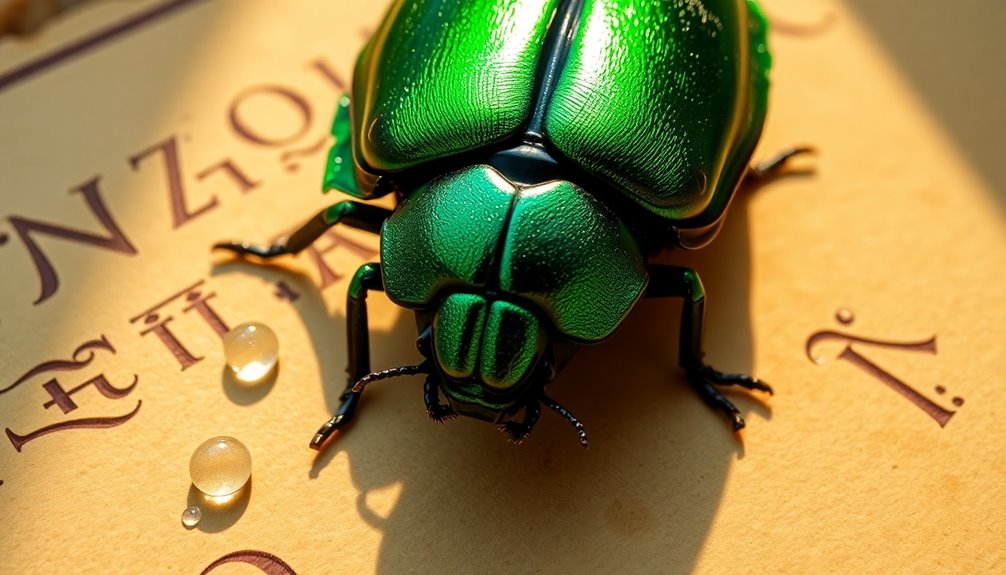
The symbolism of life and rebirth in ancient Egypt is vividly embodied in the scarab beetle, which serves as a potent reminder of the natural cycles that govern existence.
This remarkable insect, particularly the dung beetle, is known for its unique behavior of rolling dung balls and burying them underground. This act symbolizes regeneration and the continuous motion essential for life.
The scarab's connection to the sun god Khepri reinforces its significance as a symbol of creation and change. As Khepri rises each day, the scarab mirrors this eternal cycle of death and resurrection, reflecting the hope Egyptians had for the afterlife.
Here are three key aspects of the scarab's symbolism:
- Protection and Good Luck: Scarab amulets were often placed in tombs to safeguard the deceased on their journey.
- Eternal Cycle: The scarab illustrates the ongoing cycle of life, death, and rebirth.
- Divine Assistance: Winged scarabs depicted in tomb art highlight the belief in divine help during the passage to the afterlife.
Through these representations, the scarab beetle emerges as a powerful emblem of life's enduring nature and the promise of renewal.
The Role of Khepri and Other Gods
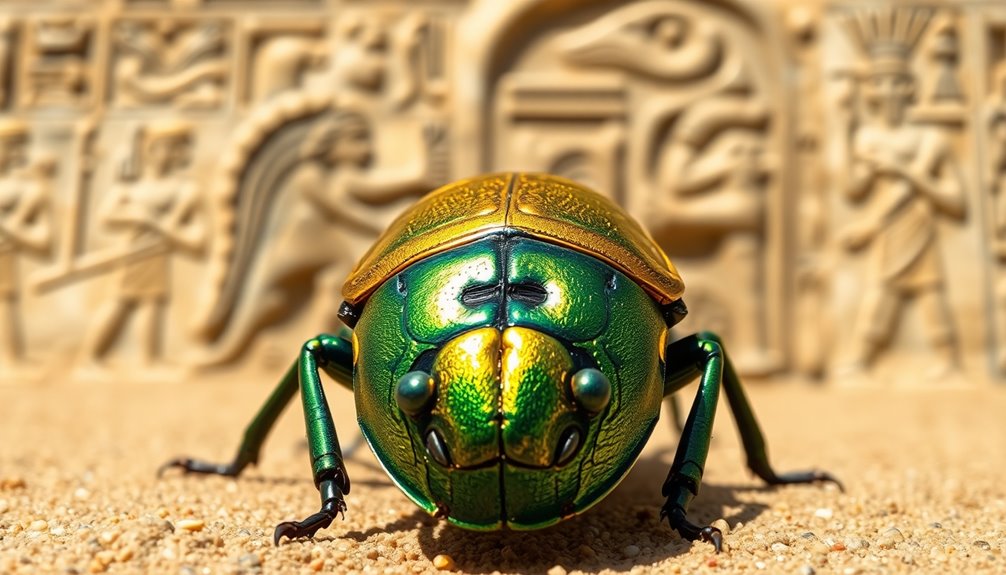
Khepri, symbolized by the scarab beetle, plays an essential role in the themes of creation and renewal in ancient Egyptian mythology.
His connection to other deities, particularly Atum, highlights a shared purpose among gods in fostering life and rebirth.
Understanding Khepri's symbolism helps you appreciate how these divine figures intertwine to embody the eternal cycle represented by scarabs.
Khepri's Symbolism in Creation
In Ancient Egyptian mythology, Khepri plays an essential role as the god of the rising sun, embodying the themes of creation and renewal. You'll see Khepri represented as a scarab beetle, which underscores his connection to life cycles and transformation. Each day, he rolls the sun across the sky, symbolizing the cyclical nature of existence.
Khepri's significance is highlighted through several key aspects of his symbolism:
- Creation and Renewal: Khepri's daily journey signifies new beginnings and the perpetual cycle of life.
- Transformation: The scarab beetle in ancient Egyptian religion represents rebirth, echoing Khepri's powers to bring forth life from the primeval waters.
- Celestial Connections: Khepri is often depicted with a blue scarab, linking him to cosmic elements and emphasizing his role in the divine order.
Through these elements, Khepri not only symbolizes the sun's daily rise but also embodies profound themes of transformation and the continuity of life.
His connection to other solar deities like Atum and Re further solidifies his importance in the rich tapestry of Egyptian mythology.
Other Deities and Scarabs
Among the pantheon of ancient Egyptian deities, Khepri stands out for his unique association with the scarab beetle, but he's not alone in this symbolism. Khepri, the god of the rising sun, embodies renewal and rebirth, representing the daily journey of the sun across the sky. His name, derived from "kheprer," directly connects him to the beetle, emphasizing themes of creation and transformation.
The scarab's significance extends beyond Khepri to other gods like Atum and Re. Together, they illustrate the interconnectedness of creation, light, and the cyclical nature of life. The blue beetle often appears in artistic representations, symbolizing celestial ties and the divine order.
In funerary contexts, scarabs play a crucial role, often found in tombs to guarantee resurrection and protection for the deceased. They signify the hope for eternal life, reflecting the ancient Egyptians' beliefs about the afterlife.
Scarabs Through Egyptian Dynasties
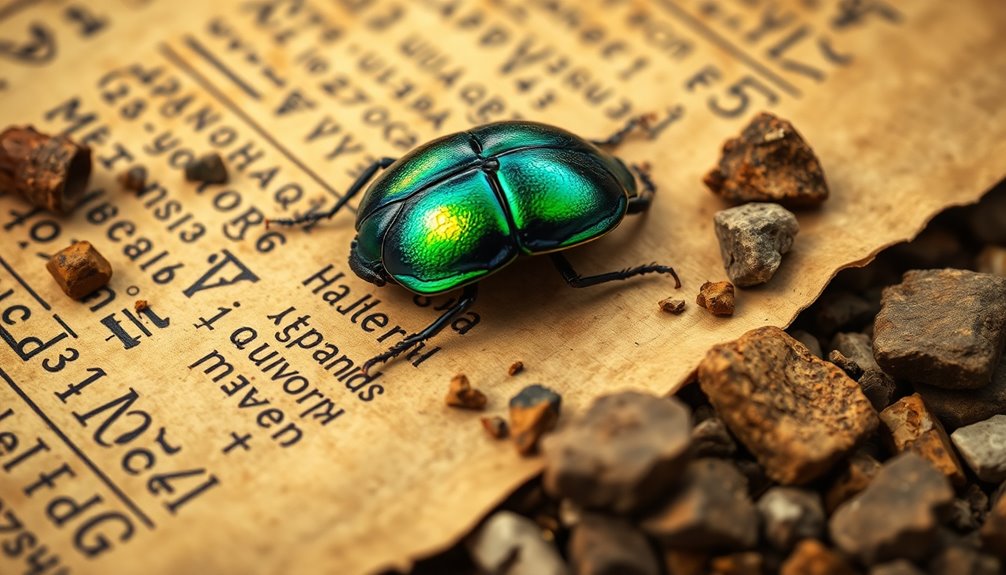
As you explore the evolution of scarabs through Egyptian dynasties, you'll notice their profound role in funerary practices and symbolism.
From simple seals in the 6th Dynasty to intricate heart scarabs in tombs, these artifacts reflect a rich tapestry of beliefs and craftsmanship.
You'll see how materials and artistry changed over time, revealing the cultural significance of scarabs both in and beyond ancient Egypt.
Scarabs in Funerary Practices
How did scarabs become essential to ancient Egyptian funerary practices? These fascinating insects weren't just symbols; they played a vital role in ensuring safe passage for the deceased into the afterlife. Scarab amulets, often placed in tombs, reflected the Egyptians' deep belief in resurrection and eternal life.
- Heart Scarabs: These specific amulets were positioned on or near the heart during mummification. They protected the heart and aided the deceased during judgment after death.
- Evolution Over Time: In the Old Kingdom, scarab amulets started as simple stone seals, but by the New Kingdom, they'd transformed into intricately crafted religious artifacts.
- Symbolism in Art: Tomb decorations frequently showcased the winged scarab, symbolizing the soul's journey and divine assistance during the passage to the afterlife.
The association of scarabs with gods like Khepri and Osiris further reinforced their significance in funerary practices. This connection linked death with themes of rebirth and regeneration, ensuring that the deceased would be granted the eternal life they sought.
Scarabs were truly the guardians of the afterlife.
Symbolism Across Dynasties
Scarabs consistently held deep symbolic meaning throughout Egypt's dynastic history, evolving alongside the civilization itself. Initially appearing during the 6th Dynasty as simple, uninscribed stone seals, scarab beetles marked their entry into ancient Egyptian culture.
As time progressed into the Middle Kingdom, they transformed into official scroll seals with inscriptions, reflecting their growing importance in administrative and ceremonial contexts.
By the New Kingdom, their religious significance soared. Intricately designed heart scarabs found in tombs became essential for aiding the deceased in the afterlife. Scarabs were often associated with the gods, including solar deities like Khepri, Atum, and Re, symbolizing creation, regeneration, and the eternal cycle of life.
This connection enriched the symbolism across dynasties, showing how deeply intertwined these insects were with Egyptian beliefs.
Pharaohs, such as Amenhotep III, further emphasized this connection by producing commemorative scarabs that celebrated significant achievements, reinforcing the divine relationship between rulers and the gods.
Through these various forms and meanings, scarabs became lasting emblems of power, faith, and the relentless flow of life in ancient Egypt.
Materials and Craftsmanship
The artistry behind scarabs showcases the remarkable evolution of craftsmanship in ancient Egypt. Starting as simple, uninscribed stone seals during the 6th Dynasty, these amulets reflect the early stages of Egyptian artisanship. By the Middle Kingdom, scarabs evolved into official seals, highlighting advances in engraving techniques.
Here's how materials and craftsmanship evolved over time:
- Materials: Scarabs shifted from basic stones to more refined materials like faience, steatite, and gemstones, revealing the growing sophistication in artisan choices.
- Funerary Significance: Funerary scarabs, marked with wings symbolizing rebirth, were crafted with great care and attached to mummy wrappings, underscoring their role in burial practices.
- Heart Scarabs: These special amulets, inscribed with spells and placed in tombs, were meticulously crafted to assist the deceased in their afterlife journey, illustrating the importance of both materials and craftsmanship in funerary traditions.
This evolution not only reflects the changing artistic trends but also the deep-rooted beliefs surrounding life, death, and rebirth in ancient Egyptian culture.
Scarabs in Jewelry and Art

Throughout ancient Egyptian history, scarabs evolved from simple seals into intricate decorative pieces, enchanting art and jewelry enthusiasts alike. During the New Kingdom period, these scarabs transformed into stunning jewelry items, including necklaces, tiaras, and earrings. Crafted from materials like faience, steatite, and precious gemstones, they symbolized protection and good luck, making them highly sought after.
The detailed carvings and inscriptions on scarabs reflected their deep significance in ancient Egyptian culture and religion. You'd find winged scarabs particularly popular in funerary art, where they represented rebirth and the journey of the deceased. Often, these winged scarabs were attached to mummy wrappings, serving as a powerful symbol of renewal and transformation.
Scarabs didn't just stop enchanting the ancient world; they remain a beloved motif in modern jewelry and decor. Their enduring cultural significance continues to tie us back to ancient traditions, making scarabs a fascinating blend of history and artistry.
Whether worn or displayed, each piece tells a story, connecting you to the rich tapestry of ancient Egyptian beliefs and the artistry that celebrates them.
Funerary Practices and Afterlife Beliefs
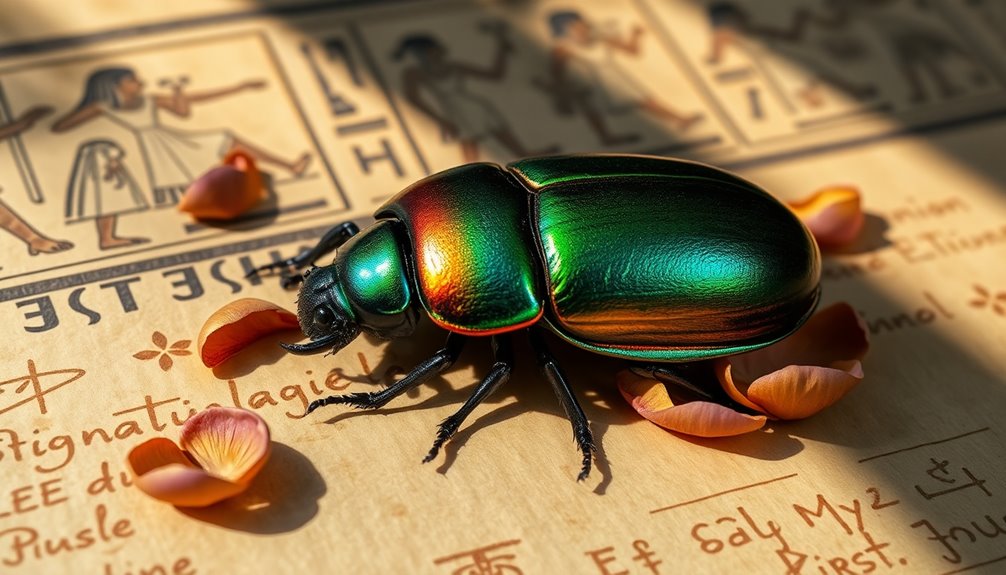
Often, ancient Egyptians placed scarab amulets in tombs to guarantee the deceased had safe passage to the afterlife. These sacred insects symbolized protection and regeneration, playing a crucial role in funerary practices. The heart scarab, inscribed with spells, was specifically positioned on the heart during mummification to assist the soul's journey.
Consider these key aspects of scarabs in funerary customs:
- Connection to Osiris: Scarabs were closely linked to Osiris, the god of the afterlife, reinforcing their significance in the afterlife journey.
- Imagery of Khepri: Tomb decorations often featured Khepri, the god associated with scarabs, representing rebirth and the cyclical nature of life and death.
- Divine Assistance: Ancient Egyptians believed that by including scarab amulets, they could secure divine support for the deceased, ensuring their immortality.
In essence, scarab amulets encapsulated the ancient Egyptians' profound beliefs in regeneration. By incorporating these insects into their burial practices, they sought not just protection but a meaningful connection to the afterlife, emphasizing their reverence for the cycle of life and death.
Modern Interpretations and Collectibility
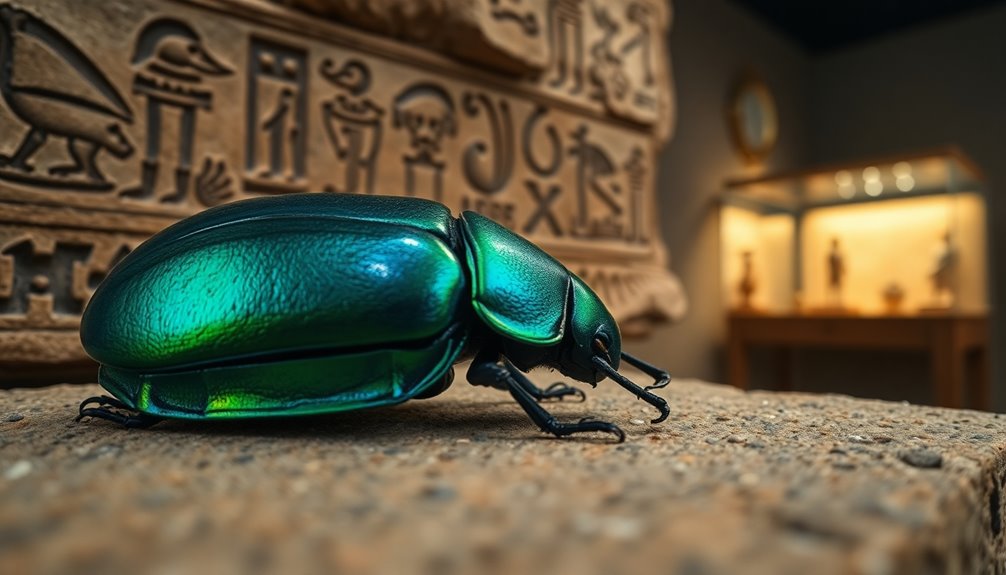
Today, many people embrace the symbolism of scarabs in jewelry and decorative arts, as these ancient insects are seen as emblems of protection and good fortune.
Modern interpretations of scarabs have transformed their role from mere artifacts of ancient Egyptians to trendy symbols of resilience and positivity in contemporary culture. You might find scarab motifs gracing everything from necklaces to home decor, reflecting their enduring allure.
Scarabs are also popular collectibles, with their value depending on size, material, and historical significance. Whether you're a casual buyer or a serious collector, exploring the world of scarab artifacts can be an exciting journey.
Major auction houses like Sotheby's and Christie's frequently feature ancient scarabs, showcasing their appeal in the art and antiques market. If you're interested in acquiring these treasures, certified dealers can provide authentic pieces, but always verify you steer clear of forgeries and illegal trade of looted artifacts.
Furthermore, scarabs inspire modern tattoos, often symbolizing themes of resurrection and renewal. This connection to ancient Egyptian traditions allows you to carry a piece of history while expressing personal significance.
Cross-Cultural Influence of Scarabs
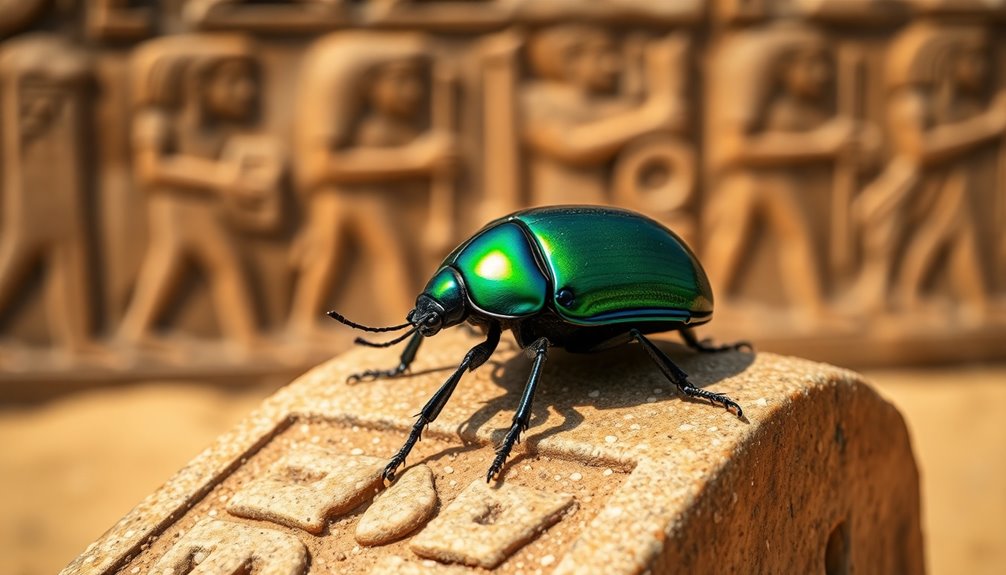
Scarabs haven't only captivated modern collectors and enthusiasts but also left a lasting imprint across various ancient cultures. This unique beetle transcended its Egyptian origins, becoming a powerful emblem of rebirth and protection throughout the Near East and the Greco-Roman world.
You can see the scarab's influence in diverse forms, as it was adopted by different civilizations, each interpreting its symbolism in fascinating ways.
- Symbolic Adoption: Many cultures embraced the scarab as a unifying symbol, reflecting shared themes of rebirth and protection.
- Artistic Integration: Scarab imagery found its way into foreign art forms, showcasing how adaptable these symbols are beyond Egypt.
- Amulets and Talismans: In addition to decorative uses, scarabs served as amulets across various societies, mirroring their original role in ancient Egyptian culture.
Today, the legacy of the scarab continues to thrive, with its motifs appearing in modern jewelry and tattoos.
This connection between contemporary society and ancient beliefs highlights the timeless allure of the scarab as a symbol of rebirth and protection.
Frequently Asked Questions
What Is the Sacred Insect in Egypt?
The sacred insect in Egypt is the scarab beetle.
It's closely linked to the god Khepri, who represents the rising sun and rebirth. You might find the scarab's behavior of rolling dung balls fascinating, as it symbolizes the eternal cycle of life.
Scarab amulets were commonly used to protect the deceased in tombs and guarantee safe passage to the afterlife, reflecting their deep cultural significance throughout ancient Egyptian history.
What Does the Egyptian Bug Symbolize?
As the saying goes, "What goes around comes around."
The Egyptian bug, particularly the scarab, symbolizes rebirth and regeneration. You'll find it closely linked to the cycle of life and death, embodying transformation and protection.
Scarabs represent divine guidance, ensuring safe passage to the afterlife. They're not just mere insects; they're powerful symbols of creation, fertility, and good fortune, often found in jewelry and amulets to invoke blessings in daily life.
What Is the Bug Egyptian God?
The bug Egyptian god is Khepri, often depicted as a scarab beetle.
You'll find that Khepri symbolizes rebirth and the rising sun, representing the eternal cycle of life. This deity plays a vital role in ancient Egyptian mythology, embodying creation and regeneration.
As you explore further, you'll discover that scarabs weren't just insects; they were sacred symbols believed to protect and guide souls in the afterlife, reflecting the culture's deep spiritual beliefs.
What Is the Secret Beetle in Egypt?
The secret beetle in Egypt is the scarab beetle, known for its symbolic connection to rebirth and resurrection.
When you think of ancient Egypt, the scarab embodies the sun's cycle of death and renewal, making it a powerful symbol of eternal life.
You might find scarabs in jewelry and artifacts, as they were believed to offer protection and good fortune, especially in funerary practices, ensuring safe passage to the afterlife.
Conclusion
In the grand tapestry of Egyptian culture, the scarab beetle symbolizes life and rebirth, a timeless emblem that still resonates today. Just like a vintage rock band revives old hits, modern interpretations breathe new life into these sacred insects. Whether you're wearing scarab jewelry or admiring ancient art, you're connecting with a legacy that spans millennia. Embrace the mystery of the scarab; it's more than just a bug—it's a powerful reminder of the cycle of existence.

